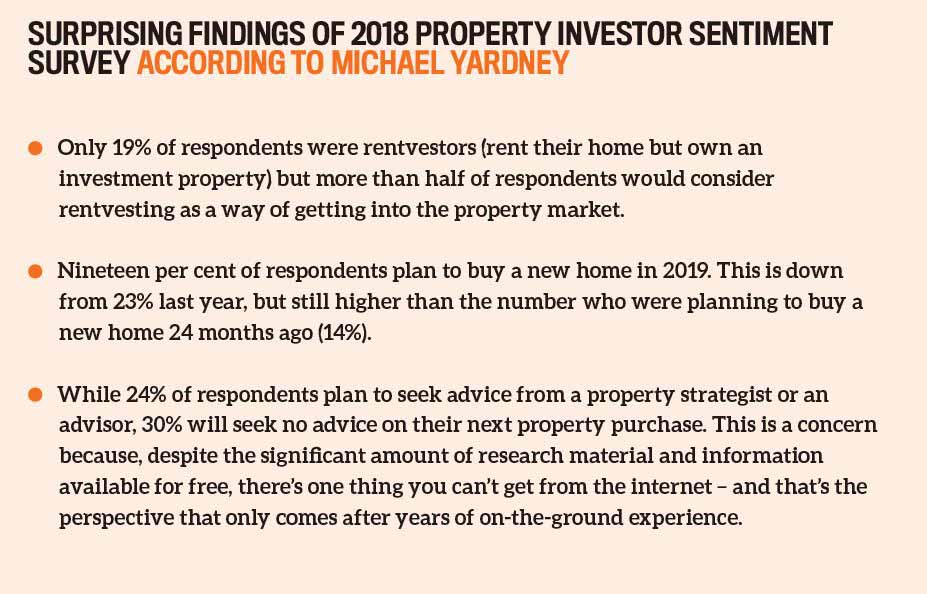
Will 2019 be the year for investors? Despite factors like falling property prices, many seem to think so, according to the results of the 2018 Property Investor Sentiment Survey conducted jointly by Michael Yardney’s Property Update, Your Investment Property and On The House.
The survey findings show that over half of the 1,802 respondents believe that 2019 is a good time to invest in property, with 42% actively planning to buy new properties as long-term investments. An overwhelming number of respondents (84%) expect market values to either remain stagnant or drop in 2019, yet they still see potential.
Compared to 2017, however, confidence in the property market has fallen as negative sentiments have increased over the year. This suggests that the declining performance of the national property market has had a detrimental effect on buyers.
Nonetheless, Metropole Property Strategists CEO and Property Update founder Michael Yardney believes that buyers are still prepared to invest.
“It’s clear that property investor confidence is still strong, and those who can afford to are planning to remain as active as ever, buying another investment property or new home if finances allow,” he says.
“Property investor confidence is still strong, and those who can afford to are planning to remain as active as ever”
The survey results provide an interesting view of the expectations and predictions of Australia’s everyday investors regarding the property market in 2019. The majority of respondents worked with budgets based on a family income of $100,000–$200,000, and they brought varied experience of investing to the table. For instance, while most owned one investment property, there were others who owned 10 or more, resulting in a diverse pool of investors.
Now or later?
Over 50% of respondents to the survey said they invested with an aim to profit from their properties’ future capital growth, and almost 20% sought to add value and hold on to their investments.
“This shows that Australian property investors focus on long-term capital growth, rather than an immediate equity boost, while many are looking for a property that has potential to add value, rather than waiting for the market to do the heavy lifting,” Yardney says.
This desire to hold on for the long haul likely stems from the fact that investors are doubtful that we will see capital growth in the short term. One factor contributing to this has been the tight lending criteria that have slowed the markets, particularly in Melbourne and Sydney. In fact, 48% of respondents indicated that the lending restrictions had affected their ability to add to their portfolios, and 30% believe they are the biggest obstacle to buying a property.
Nonetheless, short-term investing does have its supporters – the percentage of cash flow investors increased from 11% to 14.2% in the 2017–18 period.

However, since the last survey period, the volatility of the national market has caused overall consumer confidence to fall. Although 52.6% of investors still think 2019 is a good time to enter the property market, this is a decline on 61% in 2017. More people are unsure of where the market is going, with 22.8% voicing uncertainty versus 16% in 2017.
This has visibly impacted the plans of some investors for 2019. While over half of respondents to the 2016 and 2017 surveys indicated their intention to buy more properties in the succeeding years, only 42.1% of the 2018 respondents indicated plans to purchase in 2019. Homebuyers are edging out of the market as well, with a striking 65.5% opting not to buy a home in 2019.
Where to look?
With the recent downturns in Melbourne and Sydney, Brisbane has stepped up as the capital city that nearly half of the respondents see as having the most potential for growth in the next five years. As a result, over 30% of respondents have purchased properties in this city, known for its affordability relative to its more popular peers.
Surprisingly, in spite of Perth’s rocky performance in recent years, 13.8% of respondents believe it could already be on a strong path to recovery over the period 2019 to 2024. On the flip side, even though Hobart has performed spectacularly over the last few years, only 6.5% of respondents expect this city to sustain long-term growth. This ties in with the view of some industry experts who believe that Hobart is a small economy with a low ceiling.
Houses or units?
Apartment living is increasingly popular, but not among survey respondents.
Only 6% would actively seek to purchase an apartment, and only 10.6% would go for a townhouse or villa unit. For the most part, the preference still seems to be houses (39.3% of respondents).
An interesting emerging trend is the boom of renovation and development – 34% of respondents would opt for a property that they could add value to in these ways. Indeed, 40% would rather pick an established property they could work on rather than a brand-new property (8.2%), and 27.5% believe properties with value-adding potential could be the most ideal investments for the next few years.
“Investors saw an opportunity to ‘manufacture’ capital growth by purchasing property with renovation or development potential,” Yardney says.
